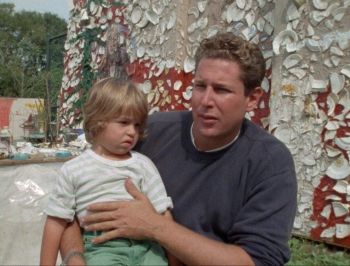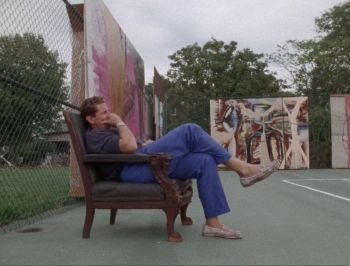Summary of Julian Schnabel
Julian Schnabel began his artistic career in the late 1970s and was part of a contingent of 1980s artists including Jean-Michel Basquiat and David Salle who endeavored to restore painting to its pre-abstraction status. Their style permitted expressivity, even exuberance, and, in contrast to the pervasive intellectualism of Minimalist and Conceptualist art of the time, balanced technical concerns with emotional resonance. As a Neo-Expressionist, Schnabel reintroduced human sentiment to painting and eschewed flatness, heaping materials onto unconventional supports such as black velvet, weathered tarpaulins, and cardboard. In addition to painting, Schnabel's expansive creative impulse led him to branch out into music, photography, and film. Schnabel has received widespread critical acclaim for work as the director of Basquiat, Before Night Falls, and The Diving Bell and the Butterfly, among other productions, although he identifies himself as a painter first and foremost.
Accomplishments
- Emerging on the heels of Minimalism and Conceptual art, Schnabel's near-mania for excess was, in itself, a potent declaration of his iconoclastic intent. His works, heavily laden not only with emotion - often there is an edge of brutal expressivity - but also quite literally with highly unconventional materials, are his manifestoes. Constructed on irregular supports like black velvet and aged tarpaulins, the lavish chaos of Schnabel's collage-like paintings is in itself a rejection of Minimalist asceticism, a true turning point for painting.
- Schnabel arrived on the New York art scene with a precocious vengeance. He acquired almost immediate renown for his outlandish behavior, outspokenness, and egotism. Reviled by some and encouraged, even adored, by others, Schnabel seemed to be reinstituting the cult of the bohemian artist as a means of shameless self-promotion. Critics contended that his work was judged less on its potential merit than on the artist's larger-than-life, charismatic, and idiosyncratic persona.
- Schnabel's work frequently features religious and, in particular, Catholic iconography and themes. His youthful engagement with Mexican culture and Meso-American religious practice when his family lived quite close to the Mexican border in Texas persisted as a lifelong fixation, which is reflected in his art. Introducing oblique religious themes in his work was a means by which Schnabel could not only infuse his paintings with meaning, but also, on a more fundamental level, connect with art history, albeit in an often satirical way.
Important Art by Julian Schnabel
Portrait of Andy Warhol
With his eerie portrait of fellow artist Andy Warhol, executed on black velvet, Schnabel has united low culture, pop art, and the high-art tradition of portraiture. The painterly style and palette are reminiscent of works by El Greco and Francis Bacon. Warhol stands dramatically alone on the right side of the composition in a sea of black velvet. Telltale paint splatters and smears partially cover the middle and the right side of the image, adding balance and mysterious depth to the composition. Known for his controlled and almost emotionless portraits of celebrities and the otherwise infamous that emphasized the homogeneity of visual reproductions, Warhol is ironically depicted with tremendous expressive impact in this portrait by Schnabel.
Oil on velvet - Hirshhorn Museum, Washington DC
The Student of Prague
The Student of Prague is one of Schnabel's famous "plate paintings" in which he applied heavy layers of pigment over broken plates and horns that were glued to a wood panel. The work is exemplary Schnabel's oeuvre of the 1980s in its massive scale and almost baroque ornamentation. The broken plates are in part representative of the influence of the work of Gaudi, whose pottery-fragment mosaics were interesting to Schnabel. Moreover, Schnabel's use of broken crockery as a painting surface signaled an overtly defiant departure from the almost sacred "flat surface" rule of Minimalist painting. This fusion of the everyday and the grandiose were characteristic of the extreme emotionalism of Schnabel's narratives.
Structurally, the work resembles a triptych, a standard format for Christian painting of the Renaissance. It is divided into three distinct sections with the middle partition rising upward and outward above the others. Connected by the unifying surface texture, the work evokes the hinged panels of its medieval and Renaissance predecessors; rough crosses appear here and there, reinforcing the Christian symbolism. The lone, ghost-like figure in the center of the composition is both integrated with and singled out from the rocky landscape of the painting's imagined and material surfaces.
Oil, plates, horns and Bondo on wood - The Guggenheim Museum, New York
Spain
This work was inspired by Schnabel's visit to Spain in the late 1970s. Like The Student of Prague, it is also a "plate painting," but here his palette is rich and earthy, evoking the Spanish landscape. The chaotic, irregular surface created by the broken crockery lends Spain a sense of danger, and the disembodied head, a standard feature in many works by Schnabel, reinforces the sense of uneasiness. Spain might be said to evoke some of the more prominent influences for Schnabel: the floating head seems straight out of a tableau by Picasso; the assembled, broken crockery are perhaps direct referents to the mosaics of Gaudi; and the rough, exuberant brushwork evokes the colorful splatters and splashes of Pollock.
Oil, plates and Bondo on wood - Guggenheim Museum, Bilbao, Spain
Untitled (Lo Tango)
Schnabel's mature work is simpler, less heavily-loaded, materially if not content-wise. Indeed, this work, Untitled (Lo Tango), while still large (92" x 68") is virtually devoid of the grossly irregular surface, appearing as if everything has been compressed toward a greater simplicity. It is a picture within a picture, in a sense a diptych that evokes the triptychs of his earlier career. A small printed canvas is mounted on the larger surface, on which Schnabel loosely applied pigment with very little blending. The brushwork is expressive but also confined to large fields of limited color. It is as though Schnabel has censored himself, reigning in the chaos inspired by the profuse materiality of his plate paintings and instead favoring the clarity of the narrative. The split canvas indicates an underlying belief of Schnabel: that a painting can tell a story or be otherwise expressive in multiple ways—here very directly via the large, overtly phallic pink blobs and the printed reproduction—inscrutable as that story may be.
Oil, gesso and printed canvas on mounted canvas - The Museum of Modern Art, New York
Fakires
Fakires is a testament to Schnabel's tendency to experiment with a variety of surfaces beyond traditional gesso-treated canvas. Here he utilizes a drop cloth, typically reserved for catching spills and other debris as the painter works. The cloth becomes critical to the painting, obscuring the canvas and suggesting that ultimate meaning is therefore at least partially inaccessible. The text scrawled across the surface of the cardboard, which Schnablel applied to the drop cloth, provides another layer of implication, another method by which the artist can inscribe content, however obscure, or insert a narrative into a work. The word "Fakires" ("fakir" is the singular) is an Arabic word that refers to a holy man or religious figure, especially one who performs a magical or miraculous feat, but also resonates with the slang term, "faker," or one who is dishonest in their actions. Sketchily painted across the surface of the image, the thinly defined letters are additional symbols that contribute to the overall mysterious connotation of the composition. Although the layering aspect of different materials along with paint is still important in his work, Schnabel has moved away from broken ceramics and instead deploys far more perishable cardboard.
Oil, resin and cardboard on cotton drop cloth - Guggenheim Museum, Bilbao, Spain
Untitled (Christ's Last Day) VI
A more recent work, Untitled (Christ's Last Day) VI, is an ink reproduction of an actual x-ray from the early-20th century. There is something exceedingly delicate about this piece, particularly in comparison to the heavily impastoed and ornamented paintings of Schnabel's earlier career. The title mentions Christianity, a frequent theme in Schnabel's work, and provokes allusions to suffering, martyrdom, and death. Christ, however, is only part of the story and, for that matter, it is surely his humanity that the artist exposes so intimately. The x-rays, found in Normandy, France when Schnabel was there shooting his film, The Diving Bell and the Butterfly, peer inside the body of an unknown person and provide a glimpse of human frailty.
Ink on polyester - Gagosian Gallery, New York
Biography of Julian Schnabel
Childhood
Julian Schnabel was born in Brooklyn, New York, on October 26, 1951 to Esta and Jack Schnabel, the youngest of three children. His long-standing fascination with Mexican culture and Catholic imagery and symbolism, so inherent to much Mexican folk art, was sparked when he was an adolescent. Leaving behind the lively Jewish community of his birthplace, at age thirteen Schnabel moved with his family to Brownsville, Texas., Brownsville was an utterly new, alien world, not far from the Mexican border, which seemed to ignite the creative spark of the inquisitive and innovative teen. As a youth, Schnabel's creative impulse was expressed in various ways; it was during those years that he determined to be an artist. He also sang in a rock band. This creative diversity set the stage for his multifaceted and prolific career.
Early Training
Schnabel received his BA in Fine Arts from the University of Houston in 1973. Shortly thereafter he returned to New York to attend the Independent Study Program at the Whitney Museum. In the late 1970s he spent time traveling in Europe and was especially impressed with the architecture of Antonio Gaudi. After returning to New York City, Schnabel took on various odd jobs, such as cab driver and cook, to support himself while continuing to produce art and promoting his work. Schnabel had his first solo show in 1979 at the Mary Boone Gallery and it was a huge commercial success.
Mature Period

Schnabel continued to live and work in New York and in 1980 he married Jaqueline Beaurang and they had three children. Schnabel's work gained favor in the 1980s in chic, up-and-coming collector circles. After his successful first solo show he continued on with three more solo shows at the Pace gallery in New York in 1984, 1986 and 1989. He was often spotted hanging out with Andy Warhol and was usually seen in public wearing his pajamas.
He is credited with playing an important role in bringing about "the return of painting" after painting had been declared "dead" by prominent theorists and artists, including the Conceptual artist Joseph Kosuth in the late 1960s. Something of a provocative and often controversial figure, Schnabel was criticized at times for making some fairly outlandish statements: for instance, he is famous for having referred to himself as the "lion of the New York art world" and declaring, "I'm as close to Picasso as you're going to get in this fucking life."

Schnabel is best known for his "plate paintings" comprised of broken plates and pottery pieces glued to large canvases and then painted. The frequently massive dimensions of his paintings (a typical work could be as large as eleven feet high and seventeen feet wide or more) and their heavy adornment with materials such as pottery, antlers, Bondo, oil pigment, and so forth could either engage or, conversely, overwhelm the viewer. Indeed, Schnabel maintained that he wanted the viewer to be, "engulfed in an emotional state," when viewing his paintings. He believed that what mattered in painting was, "not what is painted, but how it's painted."
In 1986, while still married to Jaqueline Beaurang, Schnabel met his second wife, Spanish actress Olatz Lopez Garmendia. He left Beaurang, married Garmendia and had twin boys. Schnabel's active personal life did not slow down his creative processes. In addition to painting, Schnabel's prolific creativity extended to music, photography, and film. He released an album in 1995 called Every Silver Lining has a Cloud. In 2002 Schnabel worked on the photography and art direction for the Red Hot Chili Peppers' album, By the Way. He co-wrote and directed the film Basquiat about the life and tragic death of Jean-Michel Basquiat, one of his contemporaries. Schnabel has had considerable success with his directing career, making notable films such as Before Night Falls, The Diving Bell and the Butterfly, Lou Reed's Berlin, and Miral. While filming Miral he met Rula Jebreal, who wrote the screenplay and the book that Miral was based on. Schnabel soon left his second wife for Jebreal but the two never married. He currently spends his time between homes in New York City and Spain.
The Legacy of Julian Schnabel
Schnabel's painting responded to the dry intellectualism and non-objectivity of the Minimalist and Conceptual movements, which to him were antithetical to the powerful emotional expressionism of his own painting. He was among the group of painters deemed "Neo-Expressionists," a contingent of artists of the early 1980s who are considered to have ushered in a new era painting that persists to the present day. Chief among the contributions of Neo-Expressionist artists like Schnabel, Salle, and Basquiat, was the reintroduction to painting of recognizable objects, especially the human body, at various levels of abstraction.
Influences and Connections

![Benjamin Buchloh]() Benjamin Buchloh
Benjamin Buchloh![Hal Foster]() Hal Foster
Hal Foster![Craig Owens]() Craig Owens
Craig Owens![Mira Schor]() Mira Schor
Mira Schor
Useful Resources on Julian Schnabel
- Julian Schnabel: Art and FilmBy David Moos
- Julian Schnabel: PolaroidsOur PickBy Petra Giloy-Hirtz
- Julian Scnabel: Paintings 1978-2003By Max Hollein, Ingrid Pfeiffer, Robert Fleck and Julian Schnabel
- Julian Schnabel: Permanently Becoming and the Architecture of SeeingBy Sir Norman Rosenthal
- Julian Schnabel: Works on Paper, 1976-1992By Julian Schnabel, Francesco Clemente
- Julian Schnabel: Versions of ChuckOur PickBy Georg Baselitz, Bonnie Clearwater, Rudi Fuchs and Julian Schnabel
- Julian Schnabel (2003)Our PickBy David Moos
 Ask The Art Story AI
Ask The Art Story AI
























